Resources and Development class 10 notes
Class 10.jpg)
Resources and development class 10 notes are important for conceptual understanding of students to prepare for their upcoming board exams. Resources are the various materials, substances, and assets available to individuals and society, which are used to fulfill their needs and wants. Efficient and sustainable use of these resources while ensuring their availability for future generations is the key to resource development. In class 10, students learn about different types of resources, such as natural resources and human resources, and the significance of their conservation and sustainable utilization. They also explore various methods of resource development, including recycling, conservation, and sustainable development, along with the role of government policies in promoting resource development. It is crucial for students to understand the concepts of resources and development as it enables them to appreciate the importance of sustainability and responsible resource utilization in society's long-term growth and development.
Classification of resources
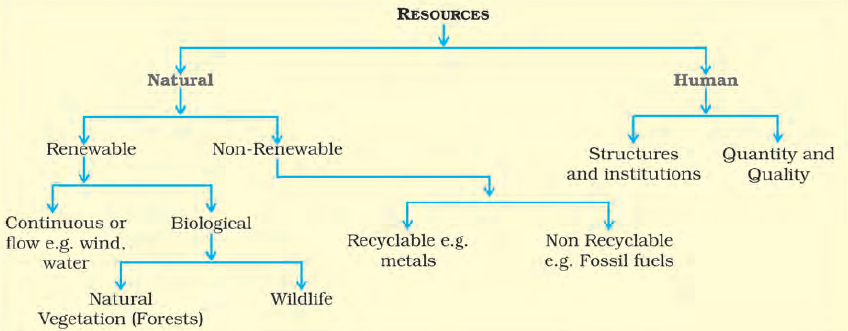
Resources can be classified in the following ways:
(a) On the basis of origin – biotic and abiotic
(b) On the basis of exhaustibility – renewable and non-renewable
(c) On the basis of ownership – individual, community, national and international
(d) On the basis of the status of development – potential, developed stock and reserves
A) On the basis of origin- biotic and abiotic
The classification of resources based on their origin includes biotic and abiotic resources. Biotic resources are those obtained from the biosphere and have life, such as human beings, flora and fauna, fisheries, and livestock. On the other hand, abiotic resources are composed of non-living things, such as rocks and metals.
B) On the basis of exhaustibility – renewable and non-renewable
Renewable or replenishable resources are those that can be renewed or reproduced through physical, chemical, or mechanical processes. They can be further divided into continuous or flow resources. Examples include solar and wind energy, water, forests, and wildlife.
Non-renewable resources, on the other hand, occur over a very long geological time and take millions of years to form. While some non-renewable resources like metals are recyclable, others like fossil fuels cannot be recycled and get exhausted with their use. Minerals and fossil fuels are examples of non-renewable resources.
C) On the basis of ownership – individual, community, national and international.
Resources can be classified based on their ownership, which includes individual, community, national, and international resources.
Individual resources are privately owned by individuals, with examples including lands in villages and plots, houses, and other properties in urban areas. These resources may include plantation, pasture lands, ponds, and water in wells.
Community-owned resources are accessible to all members of the community, such as grazing grounds, burial grounds, public parks, picnic spots, and playgrounds.
National resources are owned by a country or nation, including all minerals, water resources, forests, wildlife, land within political boundaries, and oceanic area up to 12 nautical miles (22.2 km) from the coast, termed as territorial water and resources therein. Examples of national resources include roads, canals, railways, and more.
International resources are regulated by international institutions. The oceanic resources beyond 200 nautical miles of the Exclusive Economic Zone belong to open ocean, and no individual country can utilize them without the concurrence of international institutions.
D) On the basis of the status of development – potential, developed stock and reserves.
Potential resources refer to resources found in a region but have not been utilized yet. For example, Rajasthan and Gujarat have enormous potential for the development of wind and solar energy, but they have not been developed properly.
Developed resources are resources whose quality and quantity have been determined for utilization through surveying. The development of resources depends on technology and feasibility levels.
Stock refers to materials in the environment that have the potential to satisfy human needs, but humans do not have the appropriate technology to access them. For example, hydrogen can be used as a rich source of energy, but we do not have advanced technology to use it.
Reserves are a subset of stock that can be put into use with existing technical 'know-how' but have not yet been used. They can be used to meet future requirements. For instance, water in dams, forests, etc. is a reserve that can be used in the future.
Development of Resources - Resources and Development Class 10 Notes
The development of resources refers to the process of using resources efficiently and sustainably to meet the current and future needs of society. This process involves using appropriate technology, conservation practices, and sustainable development strategies to ensure that resources are utilized responsibly and without depleting them.
The development of resources can take several forms, such as recycling, conservation, and sustainable development. Recycling involves reusing waste materials to create new products and reduce the demand for new resources. Conservation involves preserving resources through efficient use, protection, and restoration. Sustainable development aims to meet the needs of the present without compromising the ability of future generations to meet their own needs.
Resource Planning - Resources and Development Class 10 Notes
Resource planning is the process of identifying and utilizing resources in an effective and sustainable manner. It involves the development of strategies and policies to manage resources, including the allocation of resources to different sectors and regions, conservation of resources, and promotion of sustainable development
Resource planning is crucial for ensuring that resources are utilized in a responsible manner and for meeting the current and future needs of society. It helps in identifying the available resources and their potential for development, as well as the gaps and challenges in their utilization. This information can be used to prioritize the allocation of resources to different sectors and regions based on their needs and potential for development
Resource Planning in India
Resource planning involves various complex processes such as identifying and inventorying resources across the regions of the country, surveying, mapping, and estimating the quality and quantity of the resources. It also includes developing a planning structure with suitable technology, skills, and institutional setup for implementing resource development plans and aligning these plans with overall national development plans.
Appropriate technological development and institutional changes are necessary for the effective utilization of resources in promoting development. India has taken steps towards achieving the goals of resource planning since its First Five Year Plan, initiated after Independence.
To prevent irrational consumption and over-utilization of resources, resource conservation is crucial at different levels.
Land Resources
- Land is a primary natural resource and is essential for human survival and economic activities.
- It includes all the land surface of the earth, such as mountains, hills, plains, and plateaus, along with the soil, vegetation, and water bodies present on it.
- Land is used for various purposes such as agriculture, forestry, mining, industries, urbanization, and infrastructure development.
- Land is a finite resource, and its availability per capita is declining due to population growth, urbanization, and soil degradation.
- Land degradation is a serious problem that results in a decline in land productivity and quality, which affects food security and environmental sustainability.
- Land use planning is crucial for sustainable development, which involves judicious use of land resources to achieve economic, social, and environmental objectives.
Utilization of Land
The land resources are used for the following purposes:
- Forests
- Land not available for cultivation
-
a) Barren and wasteland
b) Land put to non-agricultural uses
- Fallow lands
- Other uncultivated lands (excluding fallow land)
- Net sown area.
Land Use Pattern in India -Resources and Development class 10 notes
- Physical factors: such as topography, climate, soil types
- Human factors: such as population density, technological capability and culture and traditions etc.
Land degradation is a result of human activities such as deforestation, overgrazing, mining, and quarrying. These activities have led to deep scars and traces of over-burdening the land caused by mining sites. Additionally, industrial effluents have become a major source of land and water pollution in many parts of the country.
Land degradation and conservation measures
To solve the problems of land degradation, we can take the following measures:
- Afforestation and proper management of grazing.
- Planting of shelter belts of plants.
- Stabilization of sand dunes by growing thorny bushes.
- Proper management of wastelands.
- Control of mining activities.
- Proper discharge and disposal of industrial effluents and wastes after treatment.
Soil as a Resource -Resources and Development Class 10 Notes
Soil is one of the most important natural resources on Earth. It is the foundation for plant growth, and plants are the foundation for all life on Earth. Soil is a complex mixture of organic and inorganic materials, including minerals, water, air, and microorganisms. It is a vital component of the ecosystem and plays a crucial role in food production, water management, and climate regulation. However, soil is often subjected to degradation due to various human activities such as deforestation, overgrazing, urbanization, and industrialization. Therefore, it is crucial to understand the importance of soil as a resource and take measures to conserve and manage it sustainably.
Classification of soils
There are different types of soil classified based on their properties, and they are:
-
Alluvial soil:
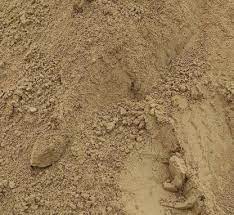
The Indus, the Ganga and the Brahmaputra have deposited Alluvial Soil throughout the entire northern plains. It is also present in Rajasthan, Gujarat and the eastern coastal plains, especially in the deltas of the Mahanadi, the Godavari, the Krishna and the Kaveri rivers. Alluvial soil is made up of varying proportions of sand, silt and clay. The size of the soil particles tends to increase towards the river valleys, and the soils are coarser on the upper side of the river valley. Alluvial soils are classified into two types based on their age:
- Old Alluvial (Bangar): This soil has a higher concentration of kanker nodules than Khadar soil.
- New Alluvial (Khadar): This soil contains more fine particles and is more fertile than Bangar soil.
Alluvial soils are highly fertile as they contain adequate proportions of potash, phosphoric acid and lime, which are ideal for the growth of sugarcane, paddy, wheat and other cereal and pulse crops
-
Black Soil :
Black soil, also known as regur soil, is formed due to a combination of climatic conditions and parent rock material. It is primarily found in the Deccan trap (Basalt) region, which is spread over the northwest Deccan plateau and is made up of lava flows. The soil is black in colour and is well-known for its capacity to hold moisture due to the extremely fine, clayey material it is made up of.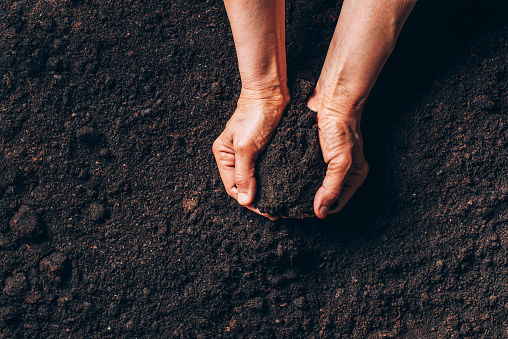
The black soil is ideal for growing cotton and is also referred to as black cotton soil. It covers the plateaus of Maharashtra, Saurashtra, Malwa, Madhya Pradesh and Chhattisgarh, and extends southeast along the Godavari and Krishna valleys. The soil is nutrient-rich, containing calcium carbonate, magnesium, potash and lime. However, it is sticky when wet and difficult to work on unless tilled immediately after the first shower or during the pre-monsoon period.
-
Red and Yellow Soil:
This type of soil develops on crystalline igneous rocks in areas of low rainfall in the eastern and southern parts of the Deccan plateau.
These soils develop a reddish colour due to diffusion of iron in crystalline and metamorphic rocks. It looks yellow when it occurs in a hydrated form.
Found in parts of Odisha, Chhattisgarh, southern parts of the middle Ganga plain and along the piedmont zone of the Western Ghats. -
Laterite Soil:
The laterite soil develops under tropical and subtropical climate with the alternate wet and dry season. This soil is the result of intense leaching due to heavy rain. Lateritic soils are acidic (pH<6.0) in nature and generally deficient in plant nutrients. This type of soil is found mostly in Southern states, Western Ghats region of Maharashtra, Odisha, some parts of West Bengal and North-east regions. The soil supports deciduous and evergreen forests but humus poor. This soil is very useful for growing tea and coffee.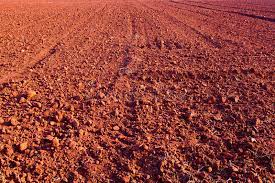
-
Arid Soil:
Arid soils range from red to brown in colour. This soil is generally sandy in texture and saline in nature. In some areas, the salt content is very high and common salt is obtained by evaporating the water. Arid soil lacks humus and moisture. The lower horizons of the soil are occupied by Kankar because of the increasing calcium content downwards. The Kankar layer formations in the bottom horizons restrict the infiltration of water. -
Forest soil:
These soils are found in the hilly and mountainous areas. The soil texture is loamy and silty in valley sides and coarse grained in the upper slopes. In the snow covered areas of Himalayas, these soils experience denudation and are acidic with low humus content. The soil is fertile on the river terraces and alluvial fans.
Soil Erosion and Soil Conservation- Resources and Development class 10 notes
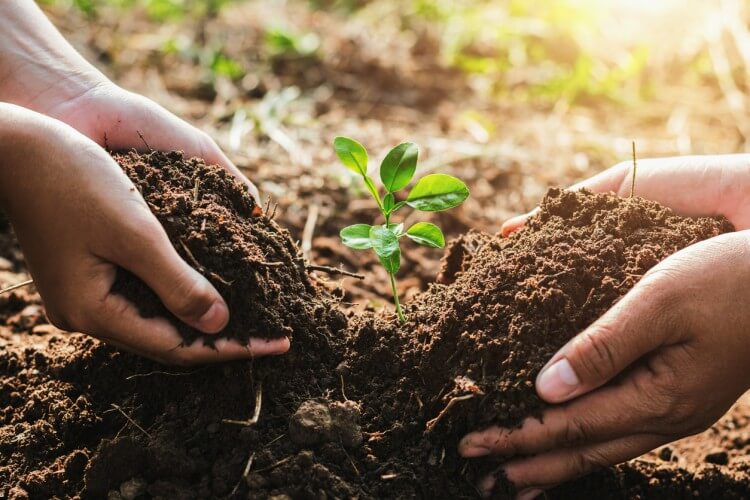
Soil erosion occurs when the soil cover is denuded and subsequently washed down. Human activities such as deforestation, over-grazing, construction, and mining, as well as natural forces such as wind, glaciers, and water, contribute to soil erosion. Additionally, faulty farming methods can cause soil erosion.
Gullies are formed when running water cuts through clayey soils, rendering the land unfit for cultivation, which is known as bad land. Sheet erosion occurs when water flows as a sheet over large areas down a slope, washing away the topsoil. Wind erosion occurs when loose soil is blown off flat or sloping land.
Soil conservation methods include contour ploughing, which involves ploughing along contour lines to decelerate the flow of water down slopes. Terrace cultivation is another method of agriculture that helps to restrict erosion, commonly practiced in Western and Central Himalayas. Strip cropping involves dividing a large field into strips and leaving strips of grass to grow between the crops, breaking up the force of the wind. Planting lines of trees to create shelter helps in stabilizing sand dunes and desert areas in western India, with rows of such trees being called shelter belts.
In conclusion, Resources and Development Class 10 Notes provide a comprehensive understanding of the various types of resources, their distribution, and utilization. Resources and Development Class 10 Notes emphasize the importance of sustainable development practices and the need to preserve our natural resources for future generations. By studying these Resources and Development Class 10 Notes, students can gain insights into the challenges of resource management and explore innovative solutions for creating a better and more sustainable future. Overall, these notes are a valuable resource for students looking to deepen their understanding of the interplay between resources, development, and the environment.
So what are you waiting for? Download the eSaral app today and take your academic success to the next level!
Also read , Notes of Money and Credit Class 10
Resources and Development class 10 notes
